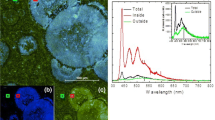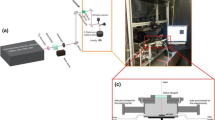Abstract
Laser is a promising technique used for biopolymer surface modification with micro and/or nano features. In this work, a 193 nm excimer laser was used for poly (ethylene terephthalate) (PET) surfaces chemical patterning. The ablation threshold of the PET film used in the experiments was 62 mJ/cm2 measured before surface modification. Surface chemical patterning was performed by irradiating PET film in a vacuum chamber filled with ammonia at the flux of 10, 15, 20, 25 ml/min. Roughness of the surface characterized by profilometry showed that there were no significant observed change after modification comparing original film. But the hydrophilicity of the surface increased after patterning and a minimum water contact angle was obtained at the gas flux of 20 ml/min. FT-IR/ATR results showed the distinct amino absorption bands presented at 3352 cm−1and 1613 cm−1 after modification and XPS binding energies of C1s at 285.5 eV and N1s at 399.0 eV verified the existence of C–N bond formation on the PET film surface. Tof-SIMS ions mapping used to identify the amine containing fragments corroborates that amino grafting mainly happened inside the laser irradiation area of the PET surface. A hypothesized radical reaction mechanism proposes that the collision between radicals in ammonia and on the PET surface caused by the incident laser provokes the grafting of amino groups.









Similar content being viewed by others
References
P. Vadgama, Surface biocompatibility. Annu. Rep. Prog. Chem. Sect. C 101, 14–52 (2005). doi:10.1039/b408906p
A. Stevens, L. Gaard-Andersen, Making waves: pattern formation by a cell-surface-associated signal. Trends Microbiol. 13, 249–252 (2005). doi:10.1016/j.tim.2005.04.002
D.R. Jung, R. Kapur, T. Adams, K.A. Giuliano, M. Mrksich, H.G. Craighead, D.L. Taylor, Topographical and physicochemical modification of material surface to enable patterning of living cells. Crit. Rev. Biotechnol. 21, 111–154 (2001). doi:10.1080/20013891081700
Y.X. Wang, J.L. Robertson, J. Spillman, R.O. Claus, Effects of the chemical structure and the surface properties of polymeric biomaterials on their biocompatibility. Pharm. Res. 21, 1362–1373 (2004). doi:10.1023/B:PHAM.0000036909.41843.18
I. Taniguchi, W.A. Kuhlman, A.M. Mayes, L.G. Griffith, Functional modification of biodegradable polyesters through a chemoselective approach: application to biomaterial surfaces. Polym. Int. 55, 1385–1397 (2006). doi:10.1002/pi.2139
J. Tang, Q. He, H. Chen, N. He, Synthesis and hybridization studies of DNA on functionalized polypropylene surfaces. J. Nanosci. Nanotechnol. 5, 1225–1229 (2005). doi:10.1166/jnn.2005.222
N. Inagaki, K. Narushima, K. Kuwabara, K. Tamura, Introduction of amino functionalities on ethylene-co-tetrafluoroethylene film surfaces by NH3 plasmas. J. Adhes. Sci. Technol. 19, 1189–1205 (2005). doi:10.1163/156856105774429064
A. Musyanovych, H.J.P. Adler, Grafting of amino functional monomer onto initiator-modified polystyrene particles. Langmuir 21, 2209–2217 (2005). doi:10.1021/la047960+
L.P. Zhu, B.K. Zhu, L. Xu, Y.X. Feng, F. Liu, Y.Y. Xu, Corona-induced graft polymerization for surface modification of porous polyethersulfone membranes. Appl. Surf. Sci. 253, 6052–6059 (2007). doi:10.1016/j.apsusc.2007.01.004
S.J. Park, J.S. Jin, Effect of corona discharge treatment on the dyeability of low-density polyethylene film. J. Colloid Interface Sci. 236, 155–160 (2001). doi:10.1006/jcis.2000.7380
N. Dumitrascu, T. Balau, M. Tasca, G. Popa, Corona discharge treatment of the plastified PVC films obtained by chemical grafting. Mater. Chem. Phys. 65, 339–344 (2000). doi:10.1016/S0254-0584(00)00261-3
J. Kim, J. Park, S. Lee, D. Sohn, Surface-grafting of polyglutamate on Si wafer using micro contact printing. Mol. Cryst. Liq. Cryst. 464, 211–216 (2007). doi:10.1080/15421400601031017
W.M. Lackowski, P. Ghosh, R.M. Crooks. Micron-scale patterning of hyperbranched polymer films by micro-contact printing. J. Am. Chem. Soc. 121, 1419–1420 (1999). doi:10.1021/ja983545q
M.L. Carbajal, E.E. Smolko, M. Grasselli, Oriented immobilization of proteins on grafted porous polymers. Nucl. Instrum. Methods Phys .Res. B 208, 416–423 (2003). doi:10.1016/S0168-583X(03)00988-1
V. Švorčík, K. Prošková, V. Hnatowicz, V. Rybka, Alanine grafting of ion-beam-modified polyethylene. J. Appl. Polym. Sci. 75, 1144–1148 (2000). doi:10.1002/(SICI)1097-4628(20000228)75:9<1144::AID-APP7>3.0.CO;2-3
K. Rajangam, H.A. Behanna, M.J. Hui, X. Han, J.F. Hulvat, J.W. Lomasney, S.I. Stupp, Heparin binding nanostructures to promote growth of blood vessels. Nano. Lett. 6, 2086–2090 (2006). doi:10.1021/nl0613555
A.K. Chakraborty, A.J. Golumbfskie, Polymer adsorption-driven self-assembly of nanostructures. Annu. Rev. Phys. Chem. 52, 537–573 (2001). doi:10.1146/annurev.physchem.52.1.537
Q. Zhao, C. Wan, J. Liu, K. Qiu, Research in synthesis of bioactive peptide RGD and the method for its grafting on PET surface. Sheng Wu Yi Xue Gong Cheng Xue Za Zhi. J. Biomed. Eng. 20, 384–387 (2003)
Z. Zhu, M.J. Kelley, Poly(ethylene terephthalate) surface modification by deep UV (172 nm) irradiation. Appl. Surf. Sci. 236, 416–425 (2004). doi:10.1016/j.apsusc.2004.05.012
C. Chollet, S. Lazare, C. Re, F. Guillemot, R. Bareille, M.C. Durrieu, RGD peptides micro-patterning on?poly(ethylene terephthalate) surfaces. ITBM-RBM 28, 2–12 (2007)
T. Sugawara, T. Matsuda, Novel surface graft copolymerization method with micron-order regional precision. Macromolecules 27, 7809–7814 (1994). doi:10.1021/ma00104a040
A. Wirsén, H. Sun, A.C. Albertsson, Solvent-free vapor-phase photografting of acrylamide onto poly(ethylene terephthalate). Biomacromolecules 6, 2697–2702 (2005). doi:10.1021/bm050169a
Z.P. Yao, B. Ranby, Surface modification by continuous graft copolymerization. III. Photoinitiated graft copolymerization onto poly(ethylene terephthalate) fiber surface. J. Appl. Polym. Sci. 41, 1459–1467 (1990). doi:10.1002/app.1990.070410709
K.S. Chen, Y.A. Ku, H.R. Lin, T.R. Yan, D.C. Sheu, T.M. Chen, Surface grafting polymerization of JV-Vinyl-2-pyrrolidone onto a poly(ethylene terephthalate) nonwoven by plasma pretreatment and its antibacterial activities. J. Appl. Polym. Sci. 100, 803–809 (2006). doi:10.1002/app.23111
C. Wu, J. Zhao, B. Zhang, M. Yuan, Surface graft polymerization of PET and PE fibers by UV irradiation. J. Dong Hua Univ. 15, 38–41 (1998). English Edition
Y.W. Song, H.S. Do, H.S. Joo, D.H. Lim, S. Kim, H.J. Kim, Effect of grafting of acrylic acid onto PET film surfaces by UV irradiation on the adhesion of PSAs. J. Adhes. Sci. Technol. 20, 1357–1365 (2006). doi:10.1163/156856106778456564
J. Wang, P. Li, H. Sun, P. Yang, Y.X. Leng, J.Y. Chen, N. Huang, Blood compatibility of chitosan immobilized on poly(ethylene terephthalate) surface modified by plasma and ultraviolet grafting. Key Eng. Mater. 288–289, 327–330 (2005)
E. Uchida, Y. Uyama, Y. Ikada, Grafting of water-soluble chains onto a polymer surface. Langmuir 10, 481–485 (1994). doi:10.1021/la00014a023
H. Watanabe, M. Yamamoto, Chemical structure change of a KrF-laser irradiated PET fiber surface. J. Appl. Polym. Sci. 71, 2027–2031 (1999). doi:10.1002/(SICI)1097-4628(19990321)71:12<2027::AID-APP12>3.0.CO;2-K
J.S. Rossier, P. Bercier, A. Schwarz, S. Loridant, H.H. Girault, Topography, crystallinity and wettability of photoablated PET surfaces. Langmuir 15, 5173–5178 (1999). doi:10.1021/la9809877
T. Lippert, T. Nakamura, H. Niino, A. Yabe, Laser induced chemical and physical modifications of polymer films: dependence on the irradiation wavelength. Appl. Surf. Sci. 109–110, 227–231 (1997). doi:10.1016/S0169-4332(96)00663-0
D. Knittel, E. Schollmeyer, Surface structuring of synthetic fibres by UV laser irradiation. Part III. Surface functionality changes resulting from excimer-laser irradiation. Polym. Int. 45, 103–109 (1998). doi:10.1002/(SICI)1097-0126(199801)45:1<103::AID-PI917>3.0.CO;2-2
M.T. Khorasani, H. Mirzadeh, P.G. Sammes, Laser surface modification of polymers to improve biocompatibility: HEMA grafted PDMS, in vitro assay - III. Radiat. Phys. Chem. 55, 685–689 (1999). doi:10.1016/S0969-806X(99)00212-1
H. Mirzadeh, A.R. Ekbatani, A.A. Katbab, Surface modification of ethylene-propylene rubber by laser grafting of acrylic acid. Iranian Polym. J. 5, 225–230 (1996). English Edition
W. Kesting, D. Knittel, E. Schollmeyer, Surface modification of polymer fibres by UV laser irradiation. X. UV-laser-induced graft copolymerization of acrylic acid onto polypropylene. Angewandte Makromolekulare Chemie. 182, 177–186 (1990). doi:10.1002/apmc.1990.051820112
H. Mirzadeh, M. Dadsetan, N. Sharifi-Sanjani, Platelet adhesion on laser-induced acrylic acid-grafted polyethylene terephthalate. J. Appl. Polym. Sci. 86, 3191–3196 (2002). doi:10.1002/app.10775
M. Dadsetan, H. Mirzadeh, N. Sharifi-Sanjani, Surface modification of polyethylene terephthalate film by CO2 laser-induced graft copolymerization of acrylamide. J. Appl. Polym. Sci. 76, 401–407 (2000). doi:10.1002/(SICI)1097-4628(20000418)76:3<401::AID-APP15>3.0.CO;2-S
H. Mirzadeh, A.A. Katbab, R.P. Burford, CO2-pulsed laser induced surface grafting of acrylamide onto ethylene-propylene rubber (EPR). II. Radiat. Phys. Chem. 42, 53–56 (1993). doi:10.1016/0969-806X(93)90201-5
I.P. Herman, Laser-assisted deposition of thin films from gas-phase and surface-adsorbed molecules. Chem. Rev. 89, 1323–1357 (1989). doi:10.1021/cr00096a005
Y.T. Chen, K. Naessens, R. Baets, Y.S. Liao, A.A. Tseng, Ablation of transparent materials using excimer lasers for photonic applications. Opt. Rev. 12, 427–441 (2005). doi:10.1007/s10043-005-0427-x
H. Watanabe, M. Yamamoto, Laser ablation of poly(ethylene terephthalate). J. Appl. Polym. Sci. 64, 1203–1209 (1997). doi:10.1002/(SICI)1097-4628(19970509)64:6<1203::AID-APP21>3.0.CO;2-V
J. Kim, D. Jung, Y. Park, Y. Kim, D.W. Moon, T.G. Lee, Quantitative analysis of surface amine groups on plasma-polymerized ethylenediamine films using UV-visible spectroscopy compared to chemical derivatization with FT-IR spectroscopy, XPS and TOF-SIMS. Appl. Surf. Sci. 253, 4112–4118 (2007). doi:10.1016/j.apsusc.2006.09.011
I.M. El Nahhal, M.M. Chehimi, C. Cordier, G. Dodin, XPS, NMR and FTIR structural characterization of polysiloxane-immobilized amine ligand systems. J. Non-Cryst. Solids 275, 142–146 (2000). doi:10.1016/S0022-3093(00)00243-X
K.S. Siow, L. Britcher, S. Kumar, H.J. Griesser, Plasma methods for the generation of chemically reactive surfaces for biomolecule immobilization and cell colonization - A review. Plasma Process. Polym. 3, 392–418 (2006). doi:10.1002/ppap.200600021
P. Laurens, S. Petit, F. Refi-Khonsari, Study of PET surfaces after laser or plasma treatment: surface modifications and adhesion properties towards Al deposition. Plasmas Polym. 8, 281–295 (2003). doi:10.1023/A:1026337227361
M.K. Shi, G. Dunham, M.E. Gross, G.L. Graff, P.M. Martin, Plasma treatment of PET and acrylic coating surfaces - I. In-situ XPS measurements. J. Adhes. Sci. Technol. 14, 1485–1498 (2000). doi:10.1163/156856100742320
W. Li, E. Ding, Characterization of PET fabrics surface modified by graft cellulose nano-crystal using TGA, FE-SEM and XPS. Surf. Rev. Lett. 13, 819–823 (2006). doi:10.1142/S0218625X06008906
N.W. Hayes, G. Beamson, D.T. Clark, D.S.L. Law, R. Raval, Crystallisation of PET from the amorphous state: observation of different rates for surface and bulk using XPS and FTIR. Surf. Interface Anal. 24, 723–728 (1996). doi:10.1002/(SICI)1096-9918(19960930)24:10<723::AID-SIA186>3.0.CO;2-Y
L.N. Bui, M. Thompson, N.B. McKeown, A.D. Romaschin, P.G. Kalman, Surface modification of the biomedical polymer poly(ethylene terephthalate). Analyst (Lond) 118, 463–474 (1993). doi:10.1039/an9931800463
C. Jie-Rong, W. Xue-Yan, W. Tomiji, Wettability of poly(ethylene terephthalate) film treated with low-temperature plasma and their surface analysis by ESCA. J. Appl. Polym. Sci. 72, 1327–1333 (1999). doi:10.1002/(SICI)1097-4628(19990606)72:10<1327::AID-APP13>3.0.CO;2-0
F.R. Lang, Y. Pitton, H.J. Mathieu, D. Landolt, E.M. Moser, Surface analysis of polyethyleneterephthalate by ESCA and TOF-SIMS. Fresenius. J. Anal. Chem. 358, 251–254 (1997). doi:10.1007/s002160050398
M. Farber, F. Huisken, Intracluster reactions: the formation of hydrazine complexes from ammonia clusters following ArF excimer laser excitation. J. Chem. Phys. 104, 4865–4868 (1996). doi:10.1063/1.471155
Y.G. Yingling, B.J. Garrison, Coarse-grained model of the interaction of light with polymeric material: onset of ablation. J. Phys. Chem. B 109, 16482–16489 (2005). doi:10.1021/jp0527711
Acknowledgements
This research was financial supported by the EU project: PROTEUS, INTERREG III A—SP1.P151/03, Spain project: BIOAVAN, PSE 300100-206 and NSFC project: 50403023. We appreciate Dr. Carmen Serra from CACTI of University of Vigo for Tof-SIMS and XPS, Yan Leping from South China University of Technology for FT-IR/ATR measurements.
Author information
Authors and Affiliations
Corresponding author
Rights and permissions
About this article
Cite this article
Wu, G., Paz, M.D., Chiussi, S. et al. Excimer laser chemical ammonia patterning on PET film. J Mater Sci: Mater Med 20, 597–606 (2009). https://doi.org/10.1007/s10856-008-3600-5
Received:
Accepted:
Published:
Issue Date:
DOI: https://doi.org/10.1007/s10856-008-3600-5




